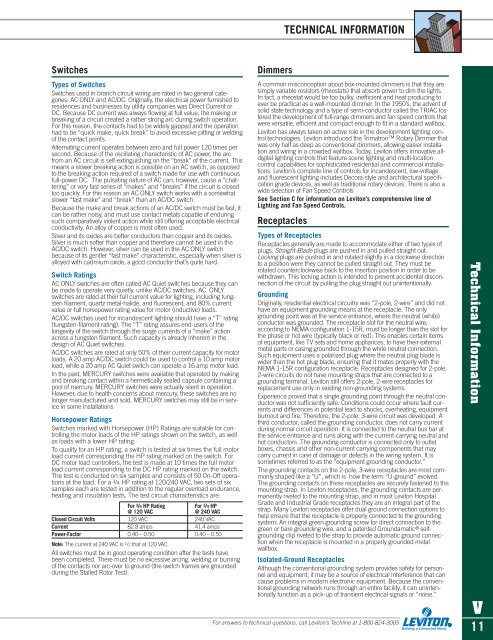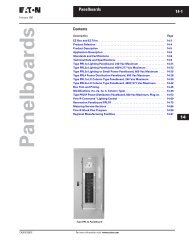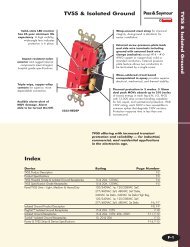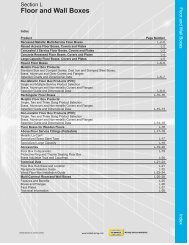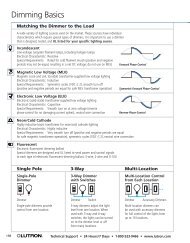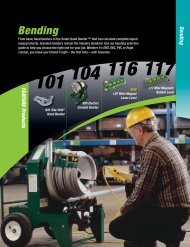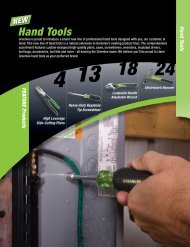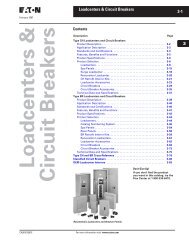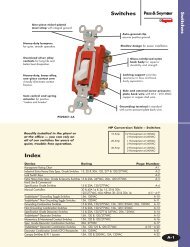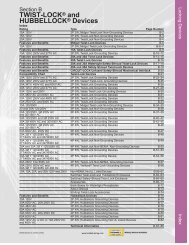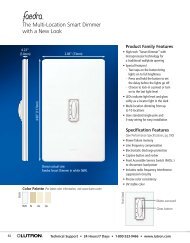Leviton Catalog - Womack Electric Supply Company
Leviton Catalog - Womack Electric Supply Company
Leviton Catalog - Womack Electric Supply Company
- No tags were found...
You also want an ePaper? Increase the reach of your titles
YUMPU automatically turns print PDFs into web optimized ePapers that Google loves.
TECHNICAL INFORMATIONSwitchesTypes of SwitchesSwitches used in branch circuit wiring are rated in two general categories:AC ONLY and AC/DC. Originally, the electrical power furnished toresidences and businesses by utility companies was Direct Current orDC. Because DC current was always flowing at full value, the making orbreaking of a circuit created a rather strong arc during switch operation.For this reason, the contacts had to be widely gapped and the operationhad to be “quick make, quick break” to avoid excessive pitting or weldingof the contact points.Alternating current operates between zero and full power 120 times persecond. Because of the oscillating characteristic of AC power, the arcfrom an AC circuit is self-extinguishing on the “break” of the current. Thismeans a slower breaking action is possible on an AC switch, as opposedto the breaking action required of a switch made for use with continuousfull-power DC. The pulsating nature of AC can, however, cause a “chattering”or very fast series of “makes” and “breaks” if the circuit is closedtoo quickly. For this reason an AC ONLY switch works with a somewhatslower “fast make” and “break” than an AC/DC switch.Because the make and break actions of an AC/DC switch must be fast, itcan be rather noisy, and must use contact metals capable of enduringsuch comparatively violent action while still offering acceptable electricalconductivity. An alloy of copper is most often used.Silver and its oxides are better conductors than copper and its oxides.Silver is much softer than copper and therefore cannot be used in theAC/DC switch. However, silver can be used in the AC ONLY switchbecause of its gentler “fast make” characteristic, especially when silver isalloyed with cadmium oxide, a good conductor that’s quite hard.Switch RatingsAC ONLY switches are often called AC Quiet switches because they canbe made to operate very quietly, unlike AC/DC switches. AC ONLYswitches are rated at their full current value for lighting, including tungstenfilament, quartz metal-halide, and fluorescent; and 80% currentvalue or full horsepower rating value for motor (inductive) loads.AC/DC switches used for incandescent lighting should have a “T” rating(tungsten-filament rating). The “T” rating assures end-users of thelongevity of the switch through the surge currents of a “make” actionacross a tungsten filament. Such capacity is already inherent in thedesign of AC Quiet switches.AC/DC switches are rated at only 50% of their current capacity for motorloads. A 20 amp AC/DC switch could be used to control a 10 amp motorload, while a 20 amp AC Quiet switch can operate a 16 amp motor load.In the past, MERCURY switches were available that operated by makingand breaking contact within a hermetically sealed capsule containing apool of mercury. MERCURY switches were actually silent in operation.However, due to health concerns about mercury, these switches are nolonger manufactured and sold. MERCURY switches may still be in servicein some installationsHorsepower RatingsSwitches marked with Horsepower (HP) Ratings are suitable for controllingthe motor loads of the HP ratings shown on the switch, as wellas loads with a lower HP rating.To qualify for an HP rating, a switch is tested at six times the full motorload current corresponding the HP rating marked on the switch. ForDC motor load controllers, the test is made at 10 times the full motorload current corresponding to the DC HP rating marked on the switch.The test is conducted on six samples and consists of 50 On-Off operationsat the load. For a 3 /4 HP rating at 120/240 VAC, two sets of sixsamples each are tested in addition to the regular overload endurance,heating and insulation tests. The test circuit characteristics are:For 3 /4 HP RatingFor 3 /4 HP@ 120 VAC@ 240 VACClosed Circuit Volts 120 VAC 240 VACCurrent 82.8 amps 41.4 ampsPower-Factor 0.40 – 0.50 0.40 – 0.50Note: The current at 240 VAC is 1 /2 that at 120 VACAll switches must be in good operating condition after the tests havebeen completed. There must be no excessive arcing, welding or burningof the contacts nor arc-over to ground (the switch frames are groundedduring the Stalled Rotor Test).DimmersA common misconception about box-mounted dimmers is that they aresimply variable resistors (rheostats) that absorb power to dim the lights.In fact, a rheostat would be too bulky, inefficient and heat producing toever be practical as a wall-mounted dimmer. In the 1950’s, the advent ofsolid state technology and a type of semi-conductor called the TRIAC fosteredthe development of full-range dimmers and fan speed controls thatwere versatile, efficient and compact enough to fit in a standard wallbox.<strong>Leviton</strong> has always taken an active role in the development lighting controltechnologies. <strong>Leviton</strong> introduced the Trimatron Rotary Dimmer thatwas only half as deep as conventional dimmers, allowing easier installationand wiring in a crowded wallbox. Today, <strong>Leviton</strong> offers innovative alldigitallighting controls that feature scene lighting and multi-locationcontrol capabilities for sophisticated residential and commercial installations.<strong>Leviton</strong>’s complete line of controls for incandescent, low-voltageand fluorescent lighting includes Decora-style and architectural specificationgrade devices, as well as traditional rotary devices. There is also awide selection of Fan Speed ControlsSee Section C for information on <strong>Leviton</strong>’s comprehensive line ofLighting and Fan Speed Controls.ReceptaclesTypes of ReceptaclesReceptacles generally are made to accommodate either of two types ofplugs. Straight-Blade plugs are pushed in and pulled straight out.Locking plugs are pushed in and rotated slightly in a clockwise directionto a position were they cannot be pulled straight out. They must berotated counterclockwise back to the insertion position in order to bewithdrawn. This locking action is intended to prevent accidental disconnectionof the circuit by pulling the plug straight out unintentionally.GroundingOriginally, residential electrical circuitry was “2-pole, 2-wire” and did nothave an equipment grounding means at the receptacle. The onlygrounding point was at the service entrance, where the neutral (white)conductor was grounded. The receptacle slot for the neutral wire,according to NEMA configuration 1-15R, must be longer than the slot forthe phase or hot wire (typically black or red). This enables certain itemsof equipment, like TV sets and home appliances, to have their externalmetal parts or casing grounded through the white neutral connection.Such equipment uses a polarized plug where the neutral plug blade iswider than the hot plug blade, ensuring that it mates properly with theNEMA 1-15R configuration receptacle. Receptacles designed for 2-pole,2-wire circuits do not have mounting straps that are connected to agrounding terminal. <strong>Leviton</strong> still offers 2-pole, 2-wire receptacles forreplacement use only in existing non-grounding systems.Experience proved that a single grounding point through the neutral conductorwas not sufficiently safe. Conditions could occur where fault currentsand differences in potential lead to shocks, overheating, equipmentburnout and fire. Therefore, the 2-pole, 3-wire circuit was developed. Athird conductor, called the grounding conductor, does not carry currentduring normal circuit operation. It is connected to the neutral bus bar atthe service entrance and runs along with the current-carrying neutral andhot conductors .The grounding conductor is connected only to outletboxes, chassis and other non-current carrying components that maycarry current in case of damage or defects in the wiring system. It issometimes referred to as the “equipment grounding conductor.”The grounding contacts on the 2-pole, 3-wire receptacles are most commonlyshaped like a “U”, which is how the term “U-ground” evolved.The grounding contacts on these receptacles are securely fastened to themounting strap. In <strong>Leviton</strong> receptacles, the grounding contacts are permanentlyriveted to the mounting strap, and in most <strong>Leviton</strong> HospitalGrade and Industrial Grade receptacles they are an integral part of thestrap. Many <strong>Leviton</strong> receptacles offer dual ground connection options tohelp ensure that the receptacle is properly connected to the groundingsystem: An integral green grounding screw for direct connection to thegreen or bare grounding wire, and a patented Groundamatic ® selfgroundingclip riveted to the strap to provide automatic ground connectionwhen the receptacle is mounted in a properly grounded metalwallbox.Isolated-Ground ReceptaclesAlthough the conventional grounding system provides safety for personneland equipment, it may be a source of electrical interference that cancause problems in modern electronic equipment. Because the conventionalgrounding network runs through an entire facility, it can unintentionallyfunction as a pick-up of transient electrical signals or “noise.”For answers to technical questions, call <strong>Leviton</strong>’s Techline at 1-800-824-3005Technical InformationV11


